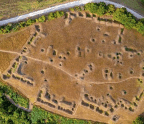To Prague, with love


“Were you frightened, little one?”
New Zealand’s During family grew up aware of their great-aunt Gertrud Kauders’ artistic talent. Ten of her drawings and watercolours were distributed among the family, and to the best of their knowledge, that was the sum of her work.
Kauders’ terrifying end was also known. Three years after Germany’s 1939 invasion of Czechoslovakia, she’d been swept up by a so-called “Strafexpedition” – a “punitive” expedition. Along with other prominent Czech artists and musicians, she was sent first to the Nazis’ Theresienstadt concentration camp north of Prague, then on to their Majdanek extermination camp in Lublin, in Nazi-occupied Poland.
The family’s knowledge of their great-aunt rested there until, in June 2018, a demolition worker probed the ceiling of a decrepit house in suburban Prague, working out how best to pull it apart. Then 30 paintings tumbled on to his head. They were signed by Gertrud Kauders.
Czech news outlets photographed and published six of the paintings. Journalists did swift research to assess Kauders’ significance within the cultural history of Prague. They reported that, in 1926, the city’s most prominent art critic, Oskar Schurer, had assessed a big exhibition of German-speaking Czech artists and listed Kauders’ paintings as the best of them. She’d been accepted for exhibition also with the so-called Prague Secession, an avant-garde group founded in 1928. Following these reports, Katerina Mikulcova, the Prague Jewish Museum’s curator, noted in the museum’s bimonthly journal, that Kauders had been considered “a great and promising talent”. However, the museum’s director, Leo Pavlat, told a reporter the museum would not curate the newly discovered art until all inheritance issues were settled.
You’re reading a preview, subscribe to read more.
Start your free 30 days





